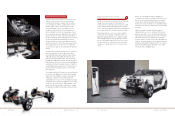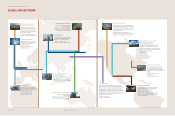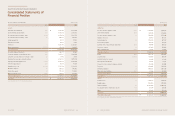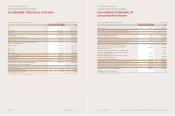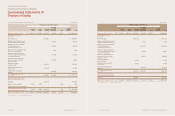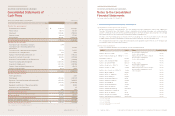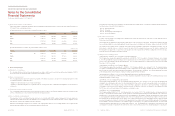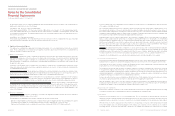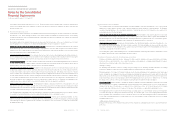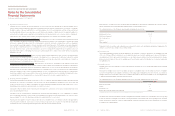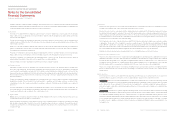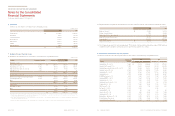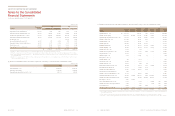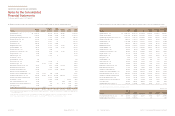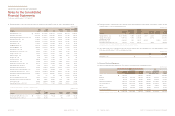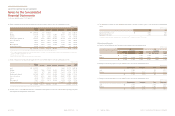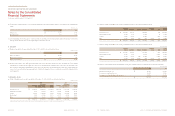Kia 2013 Annual Report Download - page 40
Download and view the complete annual report
Please find page 40 of the 2013 Kia annual report below. You can navigate through the pages in the report by either clicking on the pages listed below, or by using the keyword search tool below to find specific information within the annual report.
(g) Non-derivative financial liabilities
The Company classifies non-derivative financial liabilities into financial liabilities at fair value through profit or loss or other financial
liabilities in accordance with the substance of the contractual arrangement and the definitions of financial liabilities. The Company
recognizes financial liabilities in the consolidated statements of financial position when the Company becomes a party to the
contractual provisions of the financial liability.
FINANCIAL LIABILITIES AT FAIR VALUE THROUGH PROFIT OR LOSS
Financial liabilities at fair value through profit or loss include
financial liabilities held for trading or designated as such upon initial recognition. Subsequent to initial recognition, financial liabilities at
fair value through profit or loss are measured at fair value, and changes therein are recognized in profit or loss. Upon initial recognition,
transaction costs that are directly attributable to the acquisition are recognized in profit or loss as incurred.
OTHER FINANCIAL LIABILITIES
Non-derivative financial liabilities other than financial liabilities at fair value through profit or loss
are classified as other financial liabilities. At the date of initial recognition, other financial liabilities are measured at fair value minus
transaction costs that are directly attributable to the acquisition. Subsequent to initial recognition, other financial liabilities are measured
at amortized cost using the effective interest method.
The Company derecognizes a financial liability from the consolidated statements of financial position when it is extinguished (i.e. when
the obligation specified in the contract is discharged, cancelled or expires).
(h) Derivative financial instruments, including hedge accounting
Derivatives are initially recognized at fair value. Subsequent to initial recognition, derivatives are measured at fair value, and changes
therein are either recognized in profit or loss or, when the derivatives are designated in a hedging relationship and the hedge is
determined to be an effective hedge, other comprehensive income.
(i) Hedge accounting
The Company holds derivative contracts to manage foreign exchange risk. The Company designated derivatives as hedging
instruments to hedge the foreign currency risk of highly probable forecasted transactions (a cash flow hedge).
On initial designation of the hedge, the Company formally documents the relationship between the hedging instrument(s) and hedged
item(s), including the risk management objectives and strategy in undertaking the hedge transaction, together with the methods that
will be used to assess the effectiveness of the hedging relationship. The Company makes an assessment, both at the inception of the
hedge relationship as well as on an ongoing basis, whether the hedging instruments are expected to be “highly effective” in offsetting
the changes in the cash flows of the respective hedged items during the period for which the hedge is designated.
CASH FLOW HEDGE
When a derivative is designated to hedge the variability in cash flows attributable to a particular risk associated
with a recognized asset or liability or a highly probable forecasted transaction that could affect profit or loss, the effective portion of
changes in the fair value of the derivative is recognized in other comprehensive income, net of tax, and presented in the hedging
reserve in equity. Any ineffective portion of changes in the fair value of the derivative is recognized immediately in profit or loss.
If the hedging instrument no longer meets the criteria for hedge accounting, expires or is sold, terminated, exercised, or the designation
is revoked, then hedge accounting is discontinued prospectively. The cumulative gain or loss on the hedging instrument that has
been recognized in other comprehensive income is reclassified to profit or loss in the periods during which the forecasted transaction
occurs. If the forecasted transaction is no longer expected to occur, then the balance in other comprehensive income is recognized
immediately in profit or loss.
(ii) Other derivative financial instruments
Changes in the fair value of other derivative financial instrument not designated as a hedging instrument are recognized immediately in
profit or loss.
as an expense in the period the write-down or loss occurs. The amount of any reversal of any write-down of inventories, arising from an
increase in net realizable value, are recognized as a reduction in the amount of inventories recognized as an expense in the period in
which the reversal occurs.
(f) Non-derivative financial assets
The Company recognizes and measures non-derivative financial assets by the following four categories: financial assets at fair value
through profit or loss, held-to-maturity investments, loans and receivables and available-for-sale financial assets. The Company
recognizes financial assets in the consolidated statements of financial position when the Company becomes a party to the contractual
provisions of the instrument.
Upon initial recognition, non-derivative financial assets are measured at their fair value plus, in the case of a financial asset not at fair
value through profit or loss, transaction costs that are directly attributable to the asset’s acquisition or issuance.
FINANCIAL ASSETS AT FAIR VALUE THROUGH PROFIT OR LOSS
A financial asset is classified as financial assets are classified
at fair value through profit or loss if it is held for trading or is designated as such upon initial recognition. Upon initial recognition,
transaction costs are recognized in profit or loss when incurred. Financial assets at fair value through profit or loss are measured at fair
value, and changes therein are recognized in profit or loss.
HELD-TO-MATURITY INVESTMENTS
A non-derivative financial asset with a fixed or determinable payment and fixed maturity, for
which the Company has the positive intention and ability to hold to maturity, are classified as held-to-maturity investments. Subsequent
to initial recognition, held-to-maturity investments are measured at amortized cost using the effective interest method.
LOANS AND RECEIVABLES
Loans and receivables are financial assets with fixed or determinable payments that are not quoted in
an active market. Subsequent to initial recognition, loans and receivables are measured at amortized cost using the effective interest
method except for loans and receivables of which the effect of discounting is immaterial.
AVAILABLE-FOR-SALE FINANCIAL ASSETS
Available-for-sale financial assets are those non-derivative financial assets that are
designated as available-for-sale or are not classified as financial assets at fair value through profit or loss, held-to-maturity investments
or loans and receivables. Subsequent to initial recognition, they are measured at fair value, with changes in fair value, net of any tax
effect, recorded in other comprehensive income in equity. Investments in equity instruments that do not have a quoted market price in
an active market and whose fair value cannot be reliably measured and derivatives that are linked to and must be settled by delivery
of such unquoted equity instruments are measured at cost. When a financial asset is derecognized, the cumulative gain or loss
previously recognized in other comprehensive income is reclassified from equity to profit or loss. Dividends on an available-for-sale
equity instrument are recognized in profit or loss when the Company’s right to receive payment is established.
DERECOGNITION OF FINANCIAL ASSETS
The Company derecognizes a financial asset when the contractual rights to the cash
flows from the asset expire, or it transfers the rights to receive the contractual cash flows on the financial asset in a transaction in which
substantially all the risks and rewards of ownership of the financial asset are transferred. Any interest in transferred financial assets that
is created or retained by the Company is recognized as a separate asset or liability.
If the Company retains substantially all the risks and rewards of ownership of the transferred financial assets, the Company continues
to recognize the transferred financial assets and recognizes financial liabilities for the consideration received.
OFFSETTING BETWEEN FINANCIAL ASSETS AND FINANCIAL LIABILITIES
Financial assets and financial liabilities are offset
and the net amount is presented in the consolidated statements of financial position only when the Company currently has a legally
enforceable right to offset the recognized amounts, and there is the intention to settle on a net basis or to realize the asset and settle
the liability simultaneously.
For the years ended December 31, 2013 and 2012


